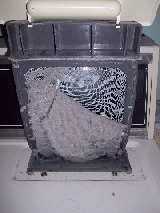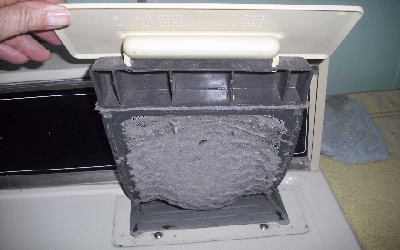| Lint screen. Lint filter. Lint traps. Lint catchers. Dryer lint removal cleaning kit |

Accumulated lint was almost
1/4" (6 mm) thick. This screen should have been cleaned after each load |
HOW OFTEN DO I HAVE TO CLEAN MY LINT SCREEN AND TRAP?
Dryer vent: after each load.
Dryer lint screen housing: Once a month.
Secondary lint trap: Once a month but check unit after each load. If there is a lot of lint after drying just one load check behind the dryer. The vent/dryer connection may have come loose or disconnected.
Entire dryer venting system: Once a year, read next section.
Annually cleaned dryer vent systems can prevent fires, speed up drying time, save energy bills, and prolong the life of your clothes dryer.
HOW TO CLEAN THE DRYER LINT SCREEN and HOUSING
If there is not a screened drain in the laundry tub, fashion one from a piece of window screen. You want to prevent wet lint from going down the drain clogging up your p-trap.
- Remove any loose lint from the trap by hand or vacuum.
- Use a scrubbing brush under running water to remove any lint residue or film.
- Rinse with clean water.
- Dry screen with a soft towel or let it air dry before placing it back in the dryer after the lint screen housing has been cleaned.
- Use a regular vacuum or shop vacuum to remove any lint from the lint screen housing.
|
|
| Clothes Dryer - Lint Control Systems |
|
|
Lint screen. Lint filter. Lint traps. Lint catchers. Dryer lint removal cleaning kit
INTRO TO DRYER LINT CONTROL
Lint is a collection of tiny bits of material that are shed from clothing in the washing machine and dryer. The dryer's lint screen catches most of these particles before the warm moist air is vented to the outside. Lint screens are also known as lint filters, lint traps or lint catchers. Clothes dryers have an built-in lint screen. A secondary lint trap may be needed to catch anything that has by-passed the primary filter located in the dryer.
Enemy #1 in the laundry room is lint. Lint that is not trapped will eventually clog dryer venting. Coiled dryer vents such as aluminum flex tubes and aluminum foil vents are especially prone to this. The dryer lint screen and the entire vent system should be cleaned often. Failing to do so will make your dryer work harder and less efficient.
More worrisome is the fact that an accumulation of lint in the dryer vent close to the dryer, can get overheated and eventually could start a fire. Choosing the right type of dryer vent is very important. There is one type of vent that is by far better than all other types. Go to Laundry Room and Dryer Vents for more information.
There are basically two types of lint control systems, one is part of the clothe dryer while the others are part of the venting system. Installing a secondary lint trap and booster fan are recommended if your dryer isn't located next to an exterior wall and requires a longer vent.
WARNING
Lint not caught by a clogged lint screen will end up in the dryer vent. A lint build-up can get overheated and is a potential fire hazard, see United States Fire Administration (USFA) statistics below. |

This dryer lint screen was not cleaned after each load |
|
|
|
SIX WARNING SIGNS OF A DIRTY LINT TRAP OR VENT
Take immediate action when you see or feel any of these warning signs. Failure to do so will lead to an overheated inefficient running dryer and a possible house fire, see United States Fire Administration (USFA) statistics below.
1- Clothes don't fully dry in the normal pre-set time. It may now take two cycles to dry the clothes that once dried in one cycle.
2- When removing items from the dryer they seem to be unusually hot.
4- The outside of the dryer gets hot.
5- The laundry room feels much warmer (or more humid) than normal.
6- With the dryer running, the hinged flappers in outside vent cap do not open much indicating the air movement was minimal.
DO NOT IGNORE ANY OF THESE WARNING SIGNS! IMMEDIATELY:
Clean all filters. Clean entire duct system, see next section. Remove dryer and vacuum all lint.
HOW TO CLEAN DRYER VENTS
This annual cleaning job is made easier if you have access to a leaf blower or shop vacuum or even better, both. You can also purchase a dryer lint removal cleaning kit which can be attached to your vacuum cleaner hose.
- Disconnect the vent from the dryer and remove the exterior dryer vent hood.
- Take the shop vacuum, insert the hose as far as you can and vacuum from both ends.
- To finish the task connect the leaf blower to the inside end and vacuum once more from the exterior side.
- Connect the duct to the dryer and reinstall the exterior vent cap.
USFA DOCUMENTED CLOTHES DRYER FIRES
The United States Fire Administration (USFA) has released a report stating that clothes dryer fires account for an estimated 12,700 residential fires, 15 deaths and 400 injuries annually. The USFA attributes “Failure to clean” as the leading factor contributing to clothes dryer fires in residential buildings.
|
|
|
|
|
Back to Top |
|